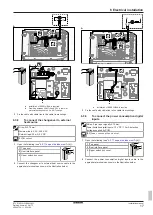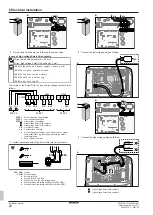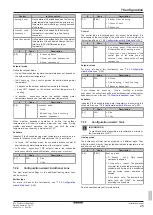
7 Configuration
Installation manual
27
ET9W
Daikin Altherma 3 H HT F
4P644730-1 – 2021.02
7.3.3
Slope-offset curve
Slope and offset
Define the weather-dependent curve by its slope and offset:
▪ Change the
slope
to differently increase or decrease the
temperature of the leaving water for different ambient
temperatures. For example, if leaving water temperature is in
general fine but at low ambient temperatures too cold, raise the
slope so that leaving water temperature is heated increasingly
more at decreasingly lower ambient temperatures.
▪ Change the
offset
to equally increase or decrease the
temperature of the leaving water for different ambient
temperatures. For example, if leaving water temperature is always
a bit too cold at different ambient temperatures, shift the offset up
to equally increase the leaving water temperature for all ambient
temperatures.
Examples
Weather-dependent curve when slope is selected:
X1
X2
c
d
e
Y1
Y2
Y3
Y4
a
b
Weather-dependent curve when offset is selected:
Y1
Y2
Y3
Y4
X1
X2
a
b
c
d
e
Item
Description
a
WD curve before changes.
b
WD curve after changes (as example):
▪ When slope is changed, the new preferred
temperature at X1 is unequally higher than the
preferred temperature at X2.
▪ When offset is changed, the new preferred
temperature at X1 is equally higher as the preferred
temperature at X2.
c
Slope
d
Offset
e
Selected weather dependent zone:
▪
: Main zone or additional zone heating
▪
: Main zone or additional zone cooling
▪
: Domestic hot water
X1, X2
Examples of outdoor ambient temperature
Item
Description
Y1, Y2,
Y3, Y4
Examples of desired tank temperature or leaving water
temperature. The icon corresponds to the heat emitter
for that zone:
▪
: Underfloor heating
▪
: Fan coil unit
▪
: Radiator
▪
: Domestic hot water tank
Possible actions on this screen
Select slope or offset.
Increase or decrease the slope/offset.
When slope is selected: set slope and go to offset.
When offset is selected: set offset.
Confirm changes and return to the submenu.
7.3.4
Using weather-dependent curves
Configure weather-dependent curves as following:
To define the setpoint mode
To use the weather-dependent curve, you need to define the correct
setpoint mode:
Go to setpoint mode …
Set the setpoint mode to …
Main zone – Heating
[2.4]
Main zone
>
Setpoint
mode
WD heating, fixed cooling
OR
Weather dependent
Main zone – Cooling
[2.4]
Main zone
>
Setpoint
mode
Weather dependent
Additional zone – Heating
[3.4]
Additional zone
>
Setpoint mode
WD heating, fixed cooling
OR
Weather dependent
Additional zone – Cooling
[3.4]
Additional zone
>
Setpoint mode
Weather dependent
Tank
[5.B]
Tank
>
Setpoint mode
Restriction:
Only available to
installers.
Weather dependent
To change the type of weather-dependent curve
To change the type for all zones (main + additional) and for the tank,
go to [2.E]
Main zone
>
WD curve type
.
Viewing which type is selected is also possible via:
▪ [3.C]
Additional zone
>
WD curve type
▪ [5.E]
Tank
>
WD curve type
Restriction:
Only available to installers.
To change the weather-dependent curve
Zone
Go to …
Main zone – Heating
[2.5]
Main zone
>
Heating WD
curve
Main zone – Cooling
[2.6]
Main zone
>
Cooling WD
curve
Additional zone – Heating
[3.5]
Additional zone
>
Heating WD curve
Additional zone – Cooling
[3.6]
Additional zone
>
Cooling WD curve




























